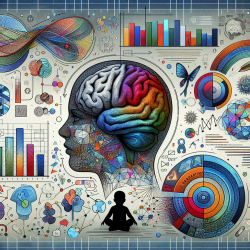In the field of Child-Robot Interaction (CRI), the ability to recognize and respond to children's emotions can significantly enhance therapeutic outcomes. A recent study titled Visual and Thermal Image Processing for Facial Specific Landmark Detection to Infer Emotions in a Child-Robot Interaction explores an innovative approach to emotion recognition using both visual and thermal imaging techniques. This blog post aims to provide practitioners with actionable insights from this research to improve their skills and encourage further exploration.
Key Findings and Practical Applications
The study utilizes a combination of visual (RGB) and Infrared Thermal Imaging (IRTI) cameras to capture facial expressions and infer emotions in children. By leveraging the Viola-Jones algorithm for initial facial detection and applying a homography matrix for accurate ROI (Region of Interest) placement, the system achieves high accuracy in emotion recognition. Here are some practical applications for practitioners:
- Enhanced Emotion Detection: The dual-camera system improves the accuracy of detecting facial landmarks, which are crucial for recognizing emotions such as disgust, fear, happiness, sadness, and surprise. Practitioners can adopt similar technology to better understand children's emotional states during therapy sessions.
- Non-Intrusive Monitoring: The use of thermal imaging allows for non-intrusive monitoring of emotional responses, which is particularly beneficial for children with Autism Spectrum Disorder (ASD) who may be sensitive to physical sensors.
- Real-Time Feedback: Integrating this system into socially assistive robots can provide real-time emotional feedback, allowing for more responsive and personalized interactions.
Encouraging Further Research
While the study shows promising results, it also highlights areas for further research. Practitioners and researchers are encouraged to explore the following:
- Extended Databases: Expanding the database to include more diverse emotional expressions and a larger sample size can improve the robustness of the emotion recognition system.
- Real-World Applications: Testing the system in real-world therapeutic settings can provide valuable insights into its practical efficacy and areas for improvement.
- Advanced Algorithms: Exploring more advanced algorithms for facial landmark detection and emotion recognition can further enhance the system's accuracy and reliability.
In conclusion, the integration of visual and thermal imaging for emotion detection in child-robot interactions holds great potential for improving therapeutic outcomes. By adopting these technologies and encouraging further research, practitioners can significantly enhance their ability to understand and respond to children's emotional needs.
To read the original research paper, please follow this link: Visual and Thermal Image Processing for Facial Specific Landmark Detection to Infer Emotions in a Child-Robot Interaction.










